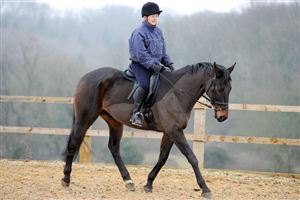Once you’ve achieved complete submission, your horse will be totally calm, relaxed and obedient, and you will hardly have to use the reins at all. He’s simply doing what horses do naturally, which is following the leader.
He looks as if he’s half asleep – great! This is exactly where you want him. Now you can start riding.
He’ll probably get agitated as you start the mounting process, so take your time. He knows what this means and now he’s worried that this lovely calm state of relaxation will blow away with the wind. If necessary, ask someone to stand at his head while you mount. They shouldn’t hang on to him, but merely be there in a supportive way. Then surprise him!
Give him a long, loose rein and carry on ‘scribbling’, as you did on the ground. Walk randomly round your space, putting in constant rein changes, large and small circles, and any other figures you can devise. It doesn’t matter what they are, as long as the horse is always listening to you. All you want is that he goes calmly and obediently where you ask him to go.
If he starts getting anxious, resist the temptation to pick up the reins and take control. Sit very still and quiet and do nothing – show by example what you want. This can often be the hardest part as every fibre in your body wants to take control – but resist this urge! The horse can only come back to the state of relaxation and submission through understanding that nothing bad is happening. From his point of view, and in this situation, control from above is bad. We must show trust.
If, once again, he has a spook or startle, or shows a dislike for a certain part of your work space, handle it exactly as you did on the ground. Simply change direction and carry on as before. Don’t do anything else. This shows your horse that you aren’t worried and gets his mind focused back on you.
Moving on
When walk is exactly right – and not before – move into trot. It may take a couple of sessions, or even more. Don’t be tempted to move into trot until your horse is completely calm and relaxed in walk. You’ll only fire him up if he isn’t ready. Continue as before, still on a loose rein and working turns, circles and figures. You should find that all it takes is the lightest touch of the rein to get the response you want.
The aim is to establish obedience from the lightest rein contact and using little more than a ‘whisper’ from the legs for the upward transitions. Keeping your legs on a nervous or excitable horse encourages him to fire up and go faster.
The aim here is to use every possible means to encourage him to calm down and relax – so keep your legs off, except when you want to tell him to walk on or trot. In this way, he becomes light and responsive to the aids and you keep him calm and relaxed. Voice commands can be useful here, all the more so if your horse is already familiar with them.
When you start riding, I recommend omitting halt, unless you’re sure that your horse can respond easily. There’s no point in getting into conflict over it. I also recommend leaving out canter, unless or until you’re sure he’ll pull up easily on a long, loose rein. Nothing is achieved by cantering round in circles, except in the context of formal schooling.
When the horse has truly settled into this way of going, more can be asked by way of formal schooling, if required, but bring it in slowly and gently, with intervals of loose rein relaxation along the way. Remember that formal schooling is hard for your horse. Like us, he needs a break from time to time.









